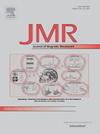The use of self-adaptive principal components in PCA-based denoising
IF 1.9
3区 化学
Q3 BIOCHEMICAL RESEARCH METHODS
引用次数: 0
Abstract
PCA-based denoising usually implies either discarding a number of high-index principal components (PCs) of a data matrix or their attenuation according to a regularization model. This work introduces an alternative, model-free, approach to high-index PC attenuation that seeks to average values of PC vectors as if they were expected from noise perturbation of data. According to the perturbation theory, the average PCs are attenuated versions of the clean PCs of noiseless data – the higher the noise-related content in a PC vector, the lower is its average’s norm. This enables a regularization of the PC expansion of data where the PC terms are self-adapted to their noise content. To approximate the average PC vectors, the data matrix is randomly sampled several times to obtain numerous pseudo-random PC sets. The PCs of same ranks are then used to reconstruct the full-data PCs of that rank. A numerical algorithm of the reconstruction and its implementation in Python are provided. The proposed automatic adaptation to data offers a convenient solution for those who face with a problem of scaling or discarding PCs in PCA-based denoising. Questions of optimal sampling schedule and sampling amount remain issues that future work must address.

自适应主成分在pca去噪中的应用。
基于pca的去噪通常意味着要么丢弃数据矩阵的一些高指数主成分(pc),要么根据正则化模型对它们进行衰减。这项工作引入了一种替代的、无模型的方法来处理高指数PC衰减,该方法寻求PC向量的平均值,就好像它们是从数据的噪声扰动中预期出来的一样。根据摄动理论,平均PC是无噪声数据的干净PC的衰减版本- PC向量中与噪声相关的内容越高,其平均范数越低。这使得PC扩展数据的正则化,其中PC项自适应于其噪声内容。为了近似平均PC向量,对数据矩阵进行多次随机采样,得到许多伪随机PC集。然后使用相同等级的pc来重建该等级的全数据pc。给出了重构的数值算法及其在Python中的实现。提出的自动适应数据的方法为基于pca的去噪中存在缩放或丢弃pc的问题提供了一种方便的解决方案。最佳抽样计划和抽样数量的问题仍然是今后工作必须解决的问题。
本文章由计算机程序翻译,如有差异,请以英文原文为准。
求助全文
约1分钟内获得全文
求助全文
来源期刊
CiteScore
3.80
自引率
13.60%
发文量
150
审稿时长
69 days
期刊介绍:
The Journal of Magnetic Resonance presents original technical and scientific papers in all aspects of magnetic resonance, including nuclear magnetic resonance spectroscopy (NMR) of solids and liquids, electron spin/paramagnetic resonance (EPR), in vivo magnetic resonance imaging (MRI) and spectroscopy (MRS), nuclear quadrupole resonance (NQR) and magnetic resonance phenomena at nearly zero fields or in combination with optics. The Journal''s main aims include deepening the physical principles underlying all these spectroscopies, publishing significant theoretical and experimental results leading to spectral and spatial progress in these areas, and opening new MR-based applications in chemistry, biology and medicine. The Journal also seeks descriptions of novel apparatuses, new experimental protocols, and new procedures of data analysis and interpretation - including computational and quantum-mechanical methods - capable of advancing MR spectroscopy and imaging.

 求助内容:
求助内容: 应助结果提醒方式:
应助结果提醒方式:


